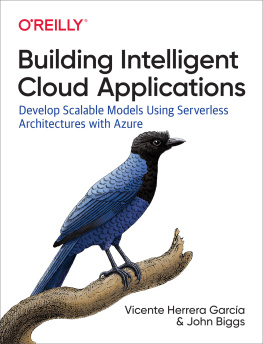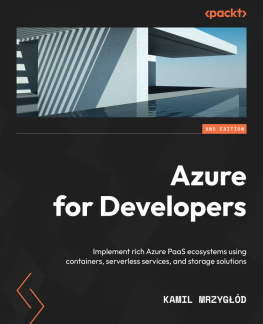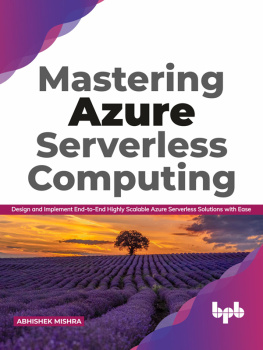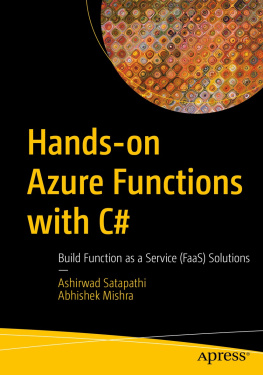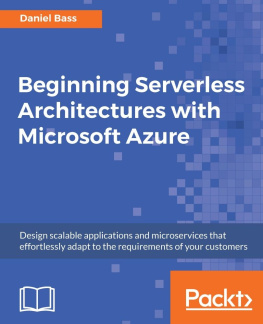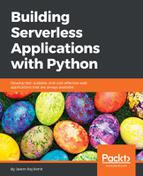John Biggs - Building Intelligent Cloud Applications: Develop Scalable Models Using Serverless Architectures with Azure
Here you can read online John Biggs - Building Intelligent Cloud Applications: Develop Scalable Models Using Serverless Architectures with Azure full text of the book (entire story) in english for free. Download pdf and epub, get meaning, cover and reviews about this ebook. year: 2019, publisher: OReilly Media, genre: Computer. Description of the work, (preface) as well as reviews are available. Best literature library LitArk.com created for fans of good reading and offers a wide selection of genres:
Romance novel
Science fiction
Adventure
Detective
Science
History
Home and family
Prose
Art
Politics
Computer
Non-fiction
Religion
Business
Children
Humor
Choose a favorite category and find really read worthwhile books. Enjoy immersion in the world of imagination, feel the emotions of the characters or learn something new for yourself, make an fascinating discovery.
- Book:Building Intelligent Cloud Applications: Develop Scalable Models Using Serverless Architectures with Azure
- Author:
- Publisher:OReilly Media
- Genre:
- Year:2019
- Rating:4 / 5
- Favourites:Add to favourites
- Your mark:
- 80
- 1
- 2
- 3
- 4
- 5
Building Intelligent Cloud Applications: Develop Scalable Models Using Serverless Architectures with Azure: summary, description and annotation
We offer to read an annotation, description, summary or preface (depends on what the author of the book "Building Intelligent Cloud Applications: Develop Scalable Models Using Serverless Architectures with Azure" wrote himself). If you haven't found the necessary information about the book — write in the comments, we will try to find it.
Building Intelligent Cloud Applications: Develop Scalable Models Using Serverless Architectures with Azure — read online for free the complete book (whole text) full work
Below is the text of the book, divided by pages. System saving the place of the last page read, allows you to conveniently read the book "Building Intelligent Cloud Applications: Develop Scalable Models Using Serverless Architectures with Azure" online for free, without having to search again every time where you left off. Put a bookmark, and you can go to the page where you finished reading at any time.
Font size:
Interval:
Bookmark:
by Vicente Herrera Garca and John Biggs
Copyright 2019 OReilly Media, Inc. All rights reserved.
Printed in the United States of America.
Published by OReilly Media, Inc. , 1005 Gravenstein Highway North, Sebastopol, CA 95472.
OReilly books may be purchased for educational, business, or sales promotional use. Online editions are also available for most titles (http://oreilly.com). For more information, contact our corporate/institutional sales department: 800-998-9938 or corporate@oreilly.com .
- Editors: Rachel Roumeliotis and Nicole Tache
- Production Editor: Kristen Brown
- Copyeditor: Octal Publishing Services, LLC
- Proofreader: Rachel Head
- Indexer: Judith McConville
- Interior Designer: David Futato
- Cover Designer: Karen Montgomery
- Illustrator: Rebecca Demarest
- April 2019: First Edition
- 2019-04-25: First Release
- 2019-09-10: Second Release
See http://oreilly.com/catalog/errata.csp?isbn=9781492052326 for release details.
The OReilly logo is a registered trademark of OReilly Media, Inc. Building Intelligent Cloud Applications, the cover image of an azure jay, and related trade dress are trademarks of OReilly Media, Inc.
The views expressed in this work are those of the authors, and do not represent the publishers views. While the publisher and the authors have used good faith efforts to ensure that the information and instructions contained in this work are accurate, the publisher and the authors disclaim all responsibility for errors or omissions, including without limitation responsibility for damages resulting from the use of or reliance on this work. Use of the information and instructions contained in this work is at your own risk. If any code samples or other technology this work contains or describes is subject to open source licenses or the intellectual property rights of others, it is your responsibility to ensure that your use thereof complies with such licenses and/or rights.
This work is part of a collaboration between OReilly and Microsoft. See our statement of editorial independence.
978-1-492-05232-6
[LSI]
The past few years have brought massive changes to the way we think about applications. As products scaled to a global level, developers worked hard to keep up, creating new paradigms that left behind the complex clientserver systems that were then in place. The resulting systems are called serverless applications, and they will be the primary focus of this book.
Most applications require computing resources, databases, and hardware. The assumption behind a program in Django, for example, is that it will be deployed in an environment that is similar or superior to the environment in which it was coded. Its also assumed that the program will be on all the time, using resources and running up a bill.
A serverless program is, in essence, a system that requires no infrastructure management, allowing the programmer to focus primarily on the business logic or functionality of the program. It is a bold change in the world of program design, and its becoming more and more popular.
To understand the implications of this model, you need to have an understanding of the basic ideas that underlie functional programming. Well review them in .
There are many different meanings, often overlapping, attributed to the terms artificial intelligence and machine learning. In this book, we concern ourselves with the ways in which we can use algorithms to find patterns hidden in large datasetspatterns that would be difficult or impossible for humans to detect without the help of computers. There are various ways in which we can set algorithms to adjust themselves to improve their performance upon each iteration. This is called machine learning .
Serverless applications and functional programming lend themselves perfectly to the exploration of these systems, and in this book you will learn how to build machine learning applications using a serverless architecture.
First, we should note that this book focuses on Azure, Microsofts cloud platform. The concepts we discuss here are universal, but our examples describe how to implement them in Azure.
The book comprises eight chapters divided into three parts.
, lays out the idea of serverless applications and explains how event-driven apps are built up from self-contained function calls hosted in the cloud. This part explains the APIs that are the interface between your locally running program and the cloud-based machine learning and data-manipulation services .
, discusses the role of data and how you make it available to your programs. The very essence of intelligence in cloud-based applications comes from the use of various machine learning techniques and models to interrogate large datasets. You dont need to build your own models; you just need to understand which ones best address the problem youre trying to solve. The functions have already been writtenyou just need to understand when and how to employ them.
, explains how to release your serverless applications into the world in a reliable, efficient, cost-effective, secure, testable manner that allows you to monitor their performance and continually improve them.
This book is for experienced programmers who would like to familiarize themselves with functional programming through the lens of machine learning. As we said, the book uses Microsofts Azure platform to build these systems, and it uses Python as the primary programming language.
When you are done with this book, we hope that you will be proficient in serverless programming in Azure as it relates to machine learning.
Examples in this book are primarily in Python 3.6. Python is a widely used open source language, with runtimes, compilers, and tools available for all operating systems. It is well suited to use with the Azure platform. Python implements an object-oriented and functional paradigm and is one of the main languages used for machine learning projects, with many open source libraries available. All serverless platforms/providers support Python. You should be aware, however, that there are many other functional languages, for example JavaScript and Clojure, that are also well suited to this kind of programming.
If you know nothing about machine learning in Python, dont worry. Well guide you through the core concepts, and the example code is meant to be short and supportive. If you find them difficult to fully understand, we encourage you to look for a short introductory Python course to get up to speed.
This book is here to help you get your job done. In general, if example code is offered in this book, you may use it in your programs and documentation. You do not need to contact us for permission unless youre reproducing a significant portion of the code. For example, writing a program that uses several chunks of code from this book does not require permission. Selling or distributing a CD-ROM of examples from OReilly books does require permission. Answering a question by citing this book and quoting example code does not require permission. Incorporating a significant amount of example code from this book into your products documentation does require permission.
We appreciate, but do not require, attribution. An attribution usually includes the title, author, publisher, and ISBN. For example:
Font size:
Interval:
Bookmark:
Similar books «Building Intelligent Cloud Applications: Develop Scalable Models Using Serverless Architectures with Azure»
Look at similar books to Building Intelligent Cloud Applications: Develop Scalable Models Using Serverless Architectures with Azure. We have selected literature similar in name and meaning in the hope of providing readers with more options to find new, interesting, not yet read works.
Discussion, reviews of the book Building Intelligent Cloud Applications: Develop Scalable Models Using Serverless Architectures with Azure and just readers' own opinions. Leave your comments, write what you think about the work, its meaning or the main characters. Specify what exactly you liked and what you didn't like, and why you think so.

